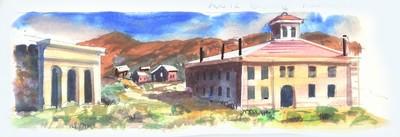Belmont, Manhattan offer ghost town experience off the beaten track

Ghosts of past mining booms, scores of ruined towns dot Nevada’s vast expanses. A lucky few survive, sustained by position along major highways like Austin or Searchlight or status as county seats like Pioche, Goldfield, Tonopah, Eureka and Virginia City. Others live well past their boom years because small populations persist, protecting the remnants of yesteryear in towns like Goodsprings, Ione and Central Nevada neighbors, Belmont and Manhattan.
Nevada’s mining ghosts lure visitors seeking glimpses of the Old West. For survival, many of Nevada’s ghost towns trade on their history to become travel destinations. While the trickle of tourists can’t rival the throngs of hopefuls who swelled the populations of promising mining camps to boomtown proportions, they do help keep the old towns on the map.
In Central Nevada, old Belmont, former Nye County seat, and its neighbor, Manhattan, offer history, scenery and outdoor adventures off the beaten tourist track. To reach these two small communities, follow U.S. 95 northwest from Las Vegas to Tonopah, 209 miles distant. In Tonopah, turn onto U.S. 6, heading east five miles to the junction with Highway 376. Head north for 13 miles to reach the paved Monitor Valley Road to Belmont, 27 miles away. About a mile before you reach Belmont, you’ll pass the gravel road that links the two old towns. Belmont’s handful of residents drive the 12-mile route to pick up their mail in Manhattan.
Two separate mining booms gave life to the pair of towns located in the wooded foothills of the Toquima range. Belmont flourished following the discovery of silver in 1865, while Manhattan grew because of renewed interest in the area generated by the booms in Goldfield and Tonopah in the early 1900s.
Belmont grew so fast that by 1866, a 10-stamp mill processed ore from its mines and five sawmills turned out mine timbers and lumber for buildings. Local building materials included an abundance of stone and clay for bricks produced by a local kiln. By 1867, Belmont’s population reached 2,000, rivaling Virginia City in size. A substantial town, it boasted a bank, churches, school, two newspapers, a general store, a post office and a score of saloons.
In 1867, the Nevada Legislature made Belmont county seat of sprawling Nye County, taking the title away from Ione, then a fading boom town. A wooden structure at first served as courthouse, later supplanted by an inadequate brick building. Finally, in 1875 the county commissioners acted to construct the handsome two-story brick Belmont courthouse, completed for $22,000 in 1876.
The new courthouse rapidly became the center of political, legal and social life in Belmont. Unfortunately, the completion of the courthouse coincided with failing fortunes in mining. Belmont began to fade, reviving briefly a few times over the next century. By 1889, most of the remaining 150 residents were county employees. In 1905, booming Tonopah wrested the county seat title from moribund Belmont. By 1911, Belmont lost its post office.
The distinctive, cupola-topped courthouse with its 19th century charm stood abandoned, protected only by vigilant residents for decades. In 1974, the county deeded the Belmont courthouse to the state. Now part of the Nevada State Parks Division, the courthouse stands stabilized and open to tours by request. Make arrangements for a tour by calling (775) 867-3001.
Today, Belmont entertains a steady stream of visitors year-round, lured by hunting, fishing, hiking, four-wheeling and horseback touring. Man of them stay in the Belmont Inn, an appealing bed and breakfast hostelry utilizing several adjacent original buildings. Guests enjoy meals cooked on a wood stove and relax in a former mine office converted to a saloon and card room. Call (775) 482-2000 for rates and reservations or visit www.belmontinn.com.
Neighboring Manhattan, meanwhile, houses about 125 permanent residents and some seasonal denizens with second homes. Quaint buildings line the streets, including two old saloons. Some buildings originated in Belmont like the wooden Catholic chapel moved from Belmont in 1908. Return to Highway 376 from Manhattan on a paved road for a loop through both historic towns.
Margo Bartlett Pesek’s column appears on Sundays.